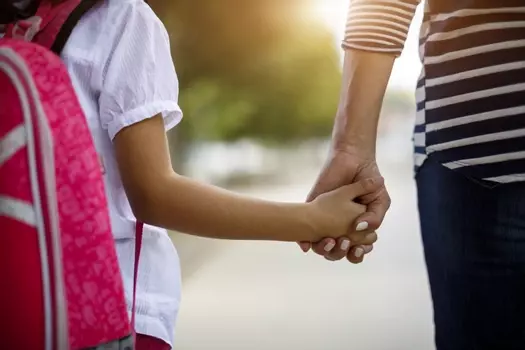Common fears and worries experienced by children
Authors Cathy Creswell and Lucy Willetts introduce the common types of fears and worries experienced by children in this edited extract from their bestselling parenting book Helping Your Child with Fears and Worries.
What do we mean by fears, worries and anxiety?
Everyone, children and adults alike, experiences worries, fears and anxiety some of the time. What they all have in common is that they involve an expectation that something bad is going to happen, a particular way in which our bodies respond to this, and certain characteristic behaviours.
When people become anxious they typically expect that something bad is about to happen. At this time thoughts tend to become focused on the potential threat and how to escape from it, and it can be hard to think about anything else. This is clearly a useful state to be in when someone is in danger. For example, if your child is about to step into the road you need to be focused on getting them out of the way of oncoming traffic and not be easily distracted by other thoughts, such as what you need to buy at the shops or what you are having for dinner.
When we experience fears and worries, we respond in a number of ways. These include our breathing getting faster, heart rate speeding up, muscles becoming tense, sweating and ‘butterflies’ in the tummy. All of these bodily signs represent our body getting ready for action, enabling us to react quickly, such as, in the above example, pulling the child out of the way before he or she comes to any harm.
The way we behave in response to fears or worries is often categorised as either ‘fight’, ‘flight’ or ‘safety-seeking’: we either fight against the threat, get out of the way as quickly as we can (take flight), or do other things that we think will keep us safe.
When we are faced with immediate threats these are, of course, the most helpful ways to respond and can be essential for our survival, but when there is no objective danger these thoughts, feelings and behaviours can cause difficulties and get in the way of day-to-day life.
How do I know if my child’s anxiety is excessive?
The changes that we experience in response to anxiety are helpful in the short term, but if these reactions continue to occur when actual danger has passed, or when, in fact, it was never there, they become problematic. When anxiety is excessive, thinking can become dominated by fearing the worst: your child may always seem to expect the worst to happen and lack confidence in their ability to cope with challenges. Bodily changes can also be very uncomfortable.
Children who are highly anxious often complain of tummy aches, headaches or muscle aches. Finally, when anxiety persists, not only is it exhausting to feel constantly ‘on edge’ but also trying to keep safe can lead your child to miss out on doing things that they would otherwise enjoy. If fears and worries are getting in the way of your child enjoying themselves or being able to do the things that other children of the same age are doing, then it is important that they are helped to overcome these difficulties.
When children with anxiety problems receive appropriate treatment, they generally do very well. Anxiety problems are extremely common among children, they can interfere with your child’s life, and they can be overcome.
types of fears and worries
All children will experience fears and worries in different ways, and it is important for you to try to get a clear understanding of your child’s unique experience. We can group certain types of anxiety problems together based on specific features or symptoms.
These groups of anxiety problems have been given labels called ‘diagnoses’. The most common categories of anxiety problems among children are: specific phobias, social anxiety, generalised anxiety, and separation anxiety. These different sorts of difficulties often go hand in hand. In fact, a child who has just one of these types of anxiety is the exception rather than the rule.
Specific phobias
When a fear of a particular place, object or situation becomes a problem it is called a phobia. This describes a fear that is excessive and leads to avoidance or extreme discomfort when a child is faced with the feared object (or place or situation). Fears are common; a lot of people are cautious of, for example, snakes or bees and this can be a healthy response. If, however, your child’s fear is significantly interfering with his or her life, such as causing problems at school, in the family or with friends, or if it stops him or her from doing things he or she would like to do, then it would no doubt be best for your child to receive help in overcoming this fear. Common fears include fears of dogs, heights, injections and vomiting.
Social anxiety
When a child is socially anxious they are typically anxious about a variety of different situations in which they fear doing something embarrassing, that people will think they are stupid, judge them negatively, or react badly to them. For children this can make it difficult to enter into situations where there will be other people – for example, going to school, being with other children (such as at parties), and going to cafés or restaurants. It may also make it hard for a child to participate in a social situation, for example, not being able to put their hand up in class or talk in a large group of peers. Although children who are socially anxious may be perfectly comfortable when they are with people they know well, they may try to avoid situations where there will be less familiar people or may feel very uncomfortable if they have to be in these kinds of situations. Occasionally, when social anxiety is severe, children are not able to talk at all in certain situations such as at school or with people outside of their home. This is commonly referred to as ‘selective mutism’.
Generalised anxiety
Generalised anxiety describes a condition where a child worries excessively and finds it hard to get worries out of his or her mind. The worries tend to be about a range of different concerns, rather than a single issue. For example, common worries can include things going on in the world (such as terrorism), doing well at school, friendships, getting things right, and the health of ourselves and others. For some children, the worries change over time, so a child can move from worrying about one thing to something else. The worries are often accompanied by unpleasant physical symptoms such as difficulty concentrating, muscle aches, sleep problems (difficulty settling or frequent waking), irritability and tiredness. Again, these difficulties can interfere with the child’s ability to enjoy activities at home, school, in the family or with friends. Generalised anxiety can present a bit differently from some of the other anxiety problems – with more worry and less avoidance.
Separation anxiety
Some children find it extremely difficult to be apart from a parent or other carer. This often relates to a fear that if they are separated from their carer they will not see each other again. This can either be because of a fear that some harm will come to the child if their carer is not present (such as they will get taken or injured), or that harm will come to their carer in the child’s absence. These fears can make it difficult for a child to take part in a range of activities that other children of the same age will be doing, including attending school, visiting friends, going to after-school clubs or activities, or going on sleepovers.
How common are anxiety problems in children?
Anxiety problems are the most common form of emotional and behavioural problems experienced by young people. Studies have estimated that about 6.5 per cent of children worldwide meet criteria for a diagnosis of an ‘anxiety disorder’. By that we mean a level of anxiety that is leading to high levels of distress and/or is causing them to miss out on age-appropriate opportunities. In other words, more than one in every twenty children is likely to have an anxiety problem that gets in the way of their day-to-day life.
In terms of particular types of anxiety disorders, findings vary across studies, but phobias have been found to affect up to a quarter of children, and other anxiety disorders like separation anxiety disorder can affect up to one in five children. Separation anxiety disorder is more commonly found among pre-adolescent children than adolescents; and social anxiety disorder is more common among adolescents than pre-adolescent children.
Will my child grow out of this problem?
Studies that have kept in touch with children with anxiety disorders over time have tended to report that symptoms can persist for several years. When we consider the effects that anxiety problems can have on children’s social lives, academic performance and mood, this presents a gloomy picture. On the other hand, it is important to stress that treatments for childhood anxiety have excellent success rates. The clear implication of this is that if your child is experiencing anxiety problems then it is important that this is recognised and dealt with.




